|
|

This chapter describes how to install and test the Cisco Metro 1500 series system chassis. The equipment is installed during normal working hours. It is usually connected to active CPU channels or control units after working hours.
This chapter includes the following sections:
Before you install the system, you must complete the following tasks:
 |
Caution Use extreme care when removing or installing connectors so you do not damage the connector housing or scratch the end-face surface of the fiber. Always install protective covers on unused or disconnected components to prevent contamination. Always clean fiber connectors before installing them. |
The Cisco Metro 1500 series system comes with the following standard items:
 |
Note The systems are used in pairs. Depending on your order, a total system package can consist of multiple boxes. All boxes are labeled with a summary of contents, and they are signed and verified by a packager. If an order includes more than one box, this summary will show the number of boxes shipped. |
The Cisco Metro 1500 series system is thoroughly inspected before shipment. If any damage has occurred during transportation or if any item is missing, notify your Cisco customer service representative immediately.
Upon receipt, inspect the equipment as follows:
Compare the equipment inside with the packing slip and the equipment list provided by customer service. If there are any discrepancies, notify the Customer Service Center.
Step 2 Check for external damage.
Visually check all components and immediately report any shipping damage to your customer service representative. Have the following information ready:
Fill out all the required information in "Unit Maintenance and Network Record," so you will have a record of all of your hardware, configuration options, and network settings.
The unit is designed for rack-mounting in a cabinet. We recommend mounting up to four units in one vertical rack and using chassis runners or telescopic slides. Use star-type lock washers on the rack screws to ensure a good conductive connection between the unit and the rack. For further information about installing the units in a customer cabinet, see the instructions from the cabinet manufacturer.
 |
Caution Because of rack mounting, the plugs of the power cables on the rear side of the unit might not be accessible. Please provide a power circuit breaker to allow front power access. If you do not use a power circuit breaker, ensure quick access to the plug-socket combinations on the rear side of the unit at all times. In this case they serve as the main means of disconnecting. |
 |
Warning Only trained and qualified personnel should be allowed to install, replace, or service this equipment. |
To install, connect, and test the system, follow these steps:
Step 2 Fill out the form in "Unit Maintenance and Network Record."
Step 3 Mount each unit in a cabinet or a rack.
Step 4 Power up each unit.
Step 5 Run online tests as described in the "Running Online Tests" section.
Step 6 Connect the fiber-optic link between sites using the remote channel.
Step 7 Connect applications using the local channels.
Step 8 Test the system online to verify operation.
 |
Note If a network element management interface (NEMI) is not installed, you have completed this portion of the installation tasks. If a NEMI is installed, refer to the Cisco Metro 1500 Series Software Configuration Guide and continue with Step 9. |
Step 9 Connect to the serial port.
Step 10 Change default passwords. See "Unit Maintenance and Network Record."
Step 11 Log in as root and define network settings. See "Unit Maintenance and Network Record."
Step 12 Change the SNMP configuration.
Step 13 Reboot the unit.
To install a NEMI module (master and slave, as applicable), follow these steps:
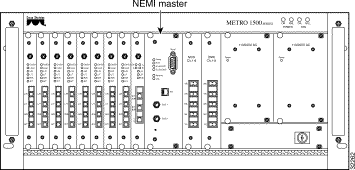
Step 2 Remove the two screws from the blank filler module. Remove the blank filler panels.
Step 3 Take the new module from the shipping container and use canned, dry, oil-free, compressed air to blow off any possible dust particles.
Step 4 Insert the NEMI module carefully into the chassis slot while guiding the upper and lower edges of the module in the tracks until its connectors come into contact with the backplane connectors.
Step 5 Hold the module in position after making full contact and use the two screws on the front panel of the module to secure it in the housing. When the module is in contact with the backplane, the green power LED is on.
Step 6 Reset the NEMI modules (both master and slave, if applicable) by inserting a pointed tool into the small hole on the front panel within the first 30 seconds of installation. The green power LED comes on and the NEMI module starts up.
Step 7 Save the blank filler panels with the packaging material.
To install a DEMI module, follow these steps:

Step 2 Remove the two screws from the blank filler module. Remove the blank filler panel.
Step 3 Take the new module from the shipping container and use canned, dry, oil-free, compressed air to blow off any possible dust particles.
Step 4 Insert the DEMI module carefully into the chassis slot while guiding the upper and lower edges of the module in the tracks until its connectors come into contact with the backplane connectors.
Step 5 Hold the module in position after making full contact and use the two screws on the front panel of the module to secure it in the housing. When the module is in contact with the backplane, the green power LED is on.
Step 6 Save the blank filler panels with the packaging material.
The system is equipped with two power supplies and two power cords. The power must be turned on by the power keyswitch on the AC-powered version only. The keyswitch is secured against rotation and the key can be removed in either the on or off position. A key for powering up the system is provided with each system.
When the power is on, all of the green power supply LEDs should be on for each power supply module (PSM) and wavelength channel module (WCM). The display panel provides important system information.
 |
Warning The plug-socket combination must be accessible at all times because it serves as the main disconnecting device. |
 |
Warning This unit might have more than one power cord. To reduce the risk of electric shock, disconnect the two power supply cords before servicing the unit. |
 |
Caution Please use approved extension cords or a power circuit breaker to allow front power access. |
To connect AC power, follow these steps:
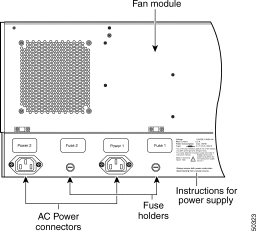
Step 2 Connect the ends of the power supply cords to the main power supply source.
Step 3 Turn the power on with the keyswitch at the front panel of the unit. (See Figure 3-4.)
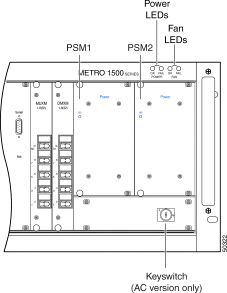
The keyswitch is secured against rotation. The key can be removed in either the ( 0 ) or ( | ) position. A pair of keys for powering up is supplied with each system.
Warm up the unit for 30 minutes before testing the laser power or connecting applications.
 |
Caution If powered down, wait at least 10 seconds before you switch the unit on again. |
To connect the power cables for the US version, follow these steps:
Step 2 Connect the wires of the cables to the terminal blocks in the rear panel of the unit. (See Figure 3-5.)
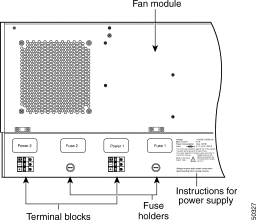
 |
Caution Do not use damaged terminal blocks. Immediately replace damaged or defective terminal blocks |
Step 3 Take a medium screwdriver and push it into the rectangular hole of the terminal block. (See Figure 3-6.) At the same time, slide the insulation-free end of the wire into the respective rectangular hole at the bottom of the power clamp. Repeat this step for the other wires.
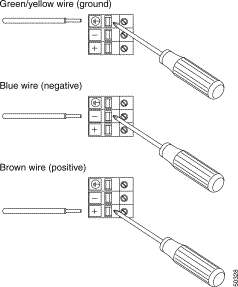
Step 4 Connect the three wires on the other end to the corresponding high current connectors of the power distribution unit. Attach the wires to their respective points in the connectors.
 |
Caution Make sure that the three wires of the power cables are correctly fixed at the clamps of the PDU connectors. |
 |
Caution Never connect blue (negative) or brown (positive) wires to the ground pin. |
Step 5 Turn the power on using the corresponding power switch of the PDU.
The chassis powers up as soon as the corresponding power switch of the PDU is turned on.
To connect the power cables for the European version, follow these steps:
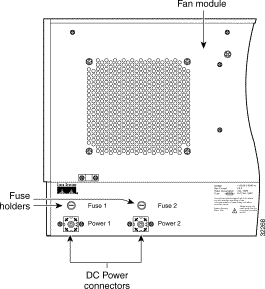
 |
Caution Tighten the screw of the plug to avoid loss of connection. |
Step 2 Choose the appropriate power cable.
Step 3 Connect the plug (the power cable for the SELV application is fitted with a special plug) to the corresponding connector of the PDU. (See Figure 3-8.)

Step 4 Attach the three wires to their respective points in the corresponding connectors of the PDU as described as follows:
Brown wire | life | + |
Blue wire | neutral | - |
Green/ Yellow wire | ground | PE |
The power cable for the 48 VDC application has wire ferrules on the other end. (See Figure 3-9.)
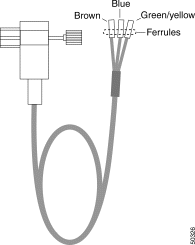
 |
Caution Make sure that the three wires on the power cables are correctly fixed at the terminal clamps of the unit and at the connectors of the PDU. |
 |
Warning This warning applies only to units equipped with DC input power supplies. Wire the DC power supply using the appropriate lugs at the wiring end. The proper wiring sequence is ground to ground, positive to positive (line to L), and negative to negative (neutral to N). Note that the ground wire should always be connected first and disconnected last. |
Step 5 Turn the power on using the corresponding power switch of the PDU.
The chassis powers up as soon as the corresponding power switch of the PDU is turned on. If the DC power cables are not connected to the PDU, the plug socket combinations on the rear end of the unit serve as switches.
The system power consumption is less than 150 W.
Use the following fuses:
| Power Type | Fuse Type | No. of Fuses |
|---|---|---|
AC version | 2.5A at 250V, slow blow, 5 x 20 mm | 2 |
DC version | 6.3A at 250V, slow blow, 5 x 20 mm | 2 |
 |
Caution Always replace blown fuses with fuses of the same type and size. |
 |
Caution Do not use damaged terminal blocks. Immediately replace damaged or defective terminal blocks. |
 |
Note The 115/230V version automatically detects the input voltage. No further adjustment is necessary. |
The Cisco Metro 1500 series system supports the following power sources:
AC | 110 to 240V, 50 or 60 Hz |
DC | -48 to -60V |
Table 3-1 lists the power requirements in different countries.
| Region | Power Requirements |
|---|---|
North America | 110 to 120 VAC, 60 Hz or |
Europe | 210 to 240 VAC, 50 Hz or |
To ground the chassis, follow these steps:
Step 2 Connect the other end of the wire to the rack.
This section describes how to clean the chassis and the connectors and includes the following sections:
Fiber optic cable connectors can be damaged by improper cleaning and connection procedures. Dirty or damaged fiber optic connectors can result in not repeatable or inaccurate communication.
Fiber optic connectors differ from electrical or microwave connectors. In a fiber optic system, light is transmitted through an extremely small fiber core. Because fiber cores are often 62.5 microns or less in diameter, and dust particles range from a tenth of a micron to several microns in diameter, dust and any contamination at the end of the fiber core can degrade the performance of the connector interface where the two cores meet. Therefore, the connector must be precisely aligned and the connector interface must be absolutely free of trapped foreign material.
Connector, or insertion, loss is a critical performance characteristic of a fiber optic connector. Return loss is also an important factor. It specifies the amount of reflected light; the lower the reflection the better the connection. The best physical contact connectors have return losses better than -40 dB, although -20 to -30 dB is more common.
The connection quality depends on two factors; the type of connector and the proper cleaning and connection techniques.Dirty fiber connectors are a common source of light loss. Keep the connectors clean at all times and keep the dust cover installed when not in use.
Before installing any type of cable or connector, use a lint-free alcohol pad from a cleaning kit to clean the ferrule, the protective white tube around the fiber, and the end-face surface of the fiber.
As a general rule, whenever there is a significant, unexplained loss of light, clean the connectors.
 |
Caution Use extreme care when removing or installing connectors so you do not damage the connector housing or scratch the end-face surface of the fiber. Always install protective covers on unused or disconnected components to prevent contamination. Always clean fiber connectors before installing them. |
Use a swab saturated with isopropyl alcohol to clean the end-surfaces. Use dry, oil-free compressed air after applying the isopropyl alcohol.
To clean the optical connectors, follow these steps:
Step 2 Blow dry the connectors with canned, dry, oil-free, compressed air.
Step 3 Use a magnifying glass to inspect the ferrule.
The connectors used inside the system have been cleaned by the manufacturer and connected to the adapters in the proper manner. The operation of the system should be error free if the customer provides clean connectors on the application side, follows the previous directions and ensures the following:
 |
Note If the surface is not clean or does not have a uniform shine, repeat the process using a fresh surface of the alcohol pad. |
This section describes how to power on the system, determine whether a power supply module (PSM) is faulty, and how to replace a PSM, if necessary.
 |
Warning Only trained and qualified personnel should be allowed to install, replace, or service this equipment. |
 |
Caution If powered off, wait at least 10 seconds before you switch the unit on again. |
Turn the power on or off using the keyswitch on the AC-powered version only. (See Figure 3-10.) This switch supplies power to the redundant power supplies. You can only move the switch to the on ( | ) or off ( 0 ) position. Two keys are shipped with each unit and all units use the same key. You can remove the key in either the on or off position.

If the LED on a power supply is off while the unit is powered on, and the power cable is plugged in the corresponding power socket, then either the cable is faulty, a fuse has blown, or the power supply itself has failed. To determine the possible cause of the failure, follow these steps:
Step 2 Check the fuses by disconnecting the power cord and opening the fuse holder. If the fuses are okay, swap out the failed power supply module.
 |
Note Check and replace the failed unit as soon as possible.While you replace the faulty power supply, the redundant power supply continues to provide uninterrupted service. |
 |
Note The power socket labeled Power 1 supplies current to the left power supply (Power 1). See Figure 3-11. The power socket labeled Power 2 supplies current to the right power supply (Power 2). |

Step 2 Pull out the malfunctioning module.
Step 3 Slide in the spare module.
Step 4 Check that the green LED is on.
Step 5 Reconnect the power cord.
Step 6 Tighten the four panel screws.
 |
Note The power levels cannot be checked without special measurement equipment because of the automatic laser shutdown (ALS). All power measurements must be done in-line because of ALS. |
Online testing varies from site to site depending on the CPU, operating systems in use, and the local channels being connected.
Be sure to set up and run your test jobs before installing the unit. Test jobs must be set up and verified by the customer prior to the actual installation of the system. For test purposes, you can force the laser on by means of the network management system as described in the Cisco Metro 1500 Series Software Configuration Guide.
 |
Note If your test results of the remote link deviate from the results described in these steps and you cannot correct the problem, contact your service representative. |
Budget measurements should be carried out at points A and F to check whether the user equipment is correctly interfaced. The budget measurement at point A should be within the range specified on the Cisco Metro 1500 series label. Measurement at point E is required to check whether the attenuation over the long distance is within the power budget. Budget measurements at point C and point D, measured at the remote side, can be used to calculate loss-levels of the connecting fiber line. All channel modules leaving the factory are accompanied by a test report.
Channel module outputs, measured at entry to the MUX, point B, or exit of the DMX, point E, are practically constant for all channel cards, whereas measurements at the exit of the BSM (point C) or entry to the BSM (point D) can exhibit a variation of 0 to 2 dB.
 |
Note All power measurements must be done in-line because of ALS. |
All measurements concerning budgets need modulated light. We recommend using an external modulated light source. Practically any low powered light source with roughly 100 MHz modulation can be used. If a need for an approved light source exists, contact your Cisco representative.
You need:
If you have an external 100-MHz modulated light source, follow Steps 1 to 3 to measure channel output at point F:
Step 2 Connect the light source output to the connector labeled L/R (local receiver) of the local channel module. As a result, the green LED of the local receiver of the channel module is on and the ALS starts working (every 10 seconds the LED for remote transmitting blinks shortly). However, the signal does not get looped
back yet.
Step 3 Use the ocmstate command to switch on the local loop. Now you can measure the output power at point F. Afterwards, switch off the local loop. To measure at points B or C, follow Steps 1 and 2 and then Step 4:
Step 4 Use the ocmstate command to switch the remote laser to "forced ON" to overcome ALS. Then measure at points B and C. If you want to measure the input at points D or E, follow Steps 1, 2, and 3 and then Step 5.
Step 5 Use ocmstate to activate the remote loopback on the remote side of the link.
The link comes up. All lasers and receivers at the channel module are on and the remote receiver and the remote transmitter at the channel module on the remote side of the link are on. The local transmitter at the channel module at the remote side of the link is also on to allow measurements.
In case you do not have an adequate external modulated light source, you can use the modulated light (100 MHz) of the pilot laser of the Cisco Metro 1500 series system's RSM (only an option if your Cisco Metro 1500 series system is equipped with an RSM). In this case, in Step 2 you connect the local RSMs B/R (output of the pilot laser) to the connector labeled L/R (local receiver) of the channel module. The output of the pilot laser is sent against traffic.
 |
Note Do not forget to set or enable clocks, disable loopback and enable automatic mode for the RSM before putting the Cisco Metro 1500 series units into service. |
If trouble occurs during installation, check Table 3-2 for a list of troubleshooting tips. If the solution is not in the table, contact your Cisco service representative.
| Problem | Probable Cause | Solution |
|---|---|---|
No power | No power is coming from the outlet. | Turn on power. |
Power cables are loose. | Check and reseat cables. | |
Power supply modules are not engaged. | Fully engage modules. | |
Power alarm | No power is coming from one outlet. | Turn on power. |
One power cable is loose. | Check and reseat cables. | |
Power supply fuse is blown. | Check and replace fuse. | |
Not receiving local data | Local channel is not online. | Place local channel online. |
Fiber-optic connectors are loose. | Check and reseat connectors. | |
Tx-Rx connectors are not matched. | Switch Tx-Rx connectors. | |
Connectors are dirty or blown. | Clean or replace connectors. | |
Local cables are not properly seated. | Trace and properly connect cables. | |
Local link power exceeds budget. | Troubleshoot and retest local link. | |
Channel card is not connected. | Connect all required optical fiber cables to the channel card. | |
Fiber links are dirty or blown. | Clean or replace fiber cables. | |
Not receiving remote data | Fiber-optic connectors are loose. | Check and reseat connectors. |
Tx-Rx connectors are not matched. | Switch Tx-Rx connectors. | |
Remote cables are not properly seated. | Trace and properly connect cable. | |
Remote link power exceeds budget. | Troubleshoot and retest remote link. | |
Channel card is not connected. | Connect all required optical fiber cables to the channel card. | |
Fiber links are dirty or blown. | Clean or replace fiber cables. | |
Inactive line is not in standby mode | Link is not connected. | Connect all required optical fiber cables of the line to the channel card. |
Remote link power exceeds budget. | Troubleshoot and retest remote link. | |
Fiber links are dirty or blown. | Clean or replace fiber cables. | |
No password prompt after entering a proper login name | A non-supported adapter is being used to connect to the Cisco Metro 1500 series serial port. | Use the supplied DB-9 to RJ-45 adapter or an adapter that includes DCD/DTR1 flow control and RTS/CTS2 flow control. |
| 1DCD/DTR = data carrier detect/data terminal ready 2RTS/CTS = request to send/clear to send |
![]()
![]()
![]()
![]()
![]()
![]()
![]()
![]()
Posted: Fri Aug 2 15:00:50 PDT 2002
All contents are Copyright © 1992--2002 Cisco Systems, Inc. All rights reserved.
Important Notices and Privacy Statement.